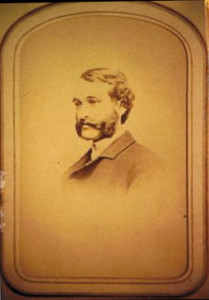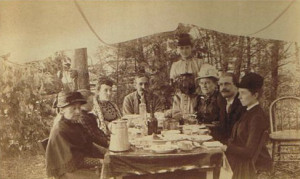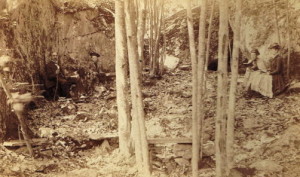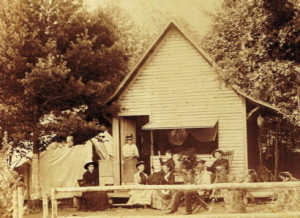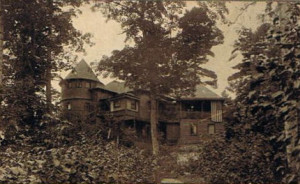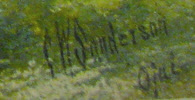Charles Wesley Sanderson, son of David Sanderson and Lucy Elwell, was born at Brandon, Vermont on July 6, 1833. As a boy, Sanderson had a natural talent for drawing and sketching but was raised to be a music teacher. However, he injured his hand and gave up the study. He then took up art, and his life as artist was devoted to water color paintings. When Scotch artist, James Hope, settled near Brandon, Sanderson was the first to study with him and learn the rudiments of oil painting. Hope recognized the young man’s talent and helped send him to Boston to study with Samuel Lancaster Gerry, who in 1858 was president of the Boston Art Club. Sanderson’s music training stood him in good stead, and he had many pupils from the Boston gentry. Eventually Gerry encouraged him to go to Paris.
Charles set out for Paris and arrived there in 1864. There he practiced drawing from life in the atelier of Julien. He was awarded two prizes for his nude sketches and was admitted to the l’Ecole des Beaux Arts for excellence in drawing. When he felt his Paris studies were ample, he went to England and turned his attention to water color painting. He employed this media throughout his long career. Returning to the continent he made the grand tour and painted landscapes in Venice, Bavaria, St. Petersburg, and Switzerland. One of his better known pictures, a product of this trip, was created in the Alps and titled The Afterglow on the Wetterhorn.
Many of his paintings adorned the homes of the foreign nobility. Afterwards, he pursued water color painting in England, returned to the United States, and continued water color painting of landscapes.
Sanderson returned to Boston with two loves – many of his European paintings and sheaves of piano music. While in Italy he had heard Franz Liszt perform in Rome. The master not only played his fiery music but also a gentle and dreamy pianoforte of Frederick Chopin. Sanderson opened a studio on Franklin Street and installed a piano as well as his paints, brushes, and easels. People coming into the building could hear the soft Chopin music echo through the halls and staircases. He had both art and music pupils, one of whom was one of S. D. Warren’s children. It was not long before Mrs. S. D. Warren purchased his Afterglow on the Wetterhorn. The Beacon Hill dowagers had a new artist to lionize, and one who could perform the latest music from Europe.
The entire world had been impressed when in 1872 Boston staged a great Peace jubilee. The idea was to commemorate a whole world practically at peace. Wars were a thing of the past, and it was celebrated with massed melodic hosannas. Sanderson sang with a representation from the Ruggles Street Church in a chorus of over 17,000 voices and an orchestra of 1,600 selected musicians from all parts of the country.
Sanderson spent his summers in Vermont painting the familiar landscapes of his youth. The pictures attracted much attention and received good prices. He entered several of these works in the 1874 Williams and Everett annual Boston Artists’ Exhibition. One of his watercolors was entitled Lana Cascade near Lake Dunmore, Vermont. Mr. Turner, a collector from Brooklyn, NY, purchased it. Another watercolor, Otter Creek Meadows, Vermont, was purchased by a Mr. Wright of Boston. Downes, the art critic of the Boston Daily Advertiser, wrote of the exhibit:
In the same gallery there is a watercolor by Mr. C. W. Sanderson, whose paintings should be more frequently exhibited. The painting is a study of the “Lana Cascade near Lake Dunmore, Vermont,” and is in most respects an excellent picture. There is nothing at all conventional about it, and one can easily see that the artist has attempted to make an accurate, careful, and truthful interpretation of the scene before him. The handling of the colors is a clear indication that the artist has skill in manipulating the brush, and it is this disclosure of reserved strength that arouses the desire to know the artist better through his paintings. The scene itself is a charming one, very familiar to be sure, but of that sort which one is never tired of seeing.
As Sanderson’s fame grew, the Brandon Union kept the local folks apprised of his activities, such as in March 1874:
Mr. C.W. Sanderson gave a charming reception on Friday afternoon, at No. 9 Ashburton place [Boston, MA], to M. Victor Maurel, when Mr. Perabo played Rubinstein’s transcription of Burger’s “Lenore,” by request, and a fantasie by Schubert. There were present, among others, Mr. Longfellow, Mr. Whittier, Gov. Washburn, Miss Preston, ex-Gov. Claflin, and Mr. and Mrs. Hiram (son of Rev. H. W.) Beecher, who are here on a visit. The occasion was delightful in all respects.
Mr. Sanderson need not be introduced to Brandon people, as he is one of their boys, who, by his own exertion and energy, has become one of the finest musical instructors in Boston. And of Mr. Perabo, it may also be said, that he is no stranger to our village. As the guest of Mr. Sanderson he has spent several summers with us; and those who have listened to his beautiful interpretation of the great masters, on a Chickering Grand, cannot but appreciate his talent as one of the finest musical artists of the country.
In November 1877, Sanderson was still noted for giving receptions to Boston notables:
A quiet and very pleasant reception was given yesterday morning by Mr. C. W. Sanderson to Mr. and Mrs. George Rignold, at Mr. Sanderson’s rooms, 7 Ashburton-place. The occasion was shorn of all unnecessary formality, and was greatly enjoyed both by the friends of Mr. Sanderson who were present and Mr. and Mrs. Rignold, who were thus enabled to meet a pleasant company of Boston people. Mrs. Harriet Beecher Stowe and her daughter, Mrs. Allen, Mrs. Erskine Clement, Miss Susan Hale, Mr. James T. Fields, and others, were present. At the request of Mr. Rignold the host performed selections from Schubert and Beethoven on the piano. Mr. Rignold is a genial, hearty gentleman in private life, and Mrs. Rignold is a lady no less charming in manner and personal appearance than her distinguished husband.
During the summer of 1878, Sanderson journeyed from Boston to Brandon for vacation. While there, he exhibited several very fine paintings at the residence of Dr. C. W. Peck, the result of his summer’s vacation. He returned to Boston in September.
Sanderson balanced the love of his Vermont homeland and metropolitan Boston. He owned a home in Brandon, and had a camp at Lake Dunmore, which he regularly visited. The camp was called Llana, named for the Falls of Llana nearby. Mrs. Almira B. Fenno-Gendrot, the wife of a painter, and a painter herself, of Boston, remembered Sanderson in 1923 when she wrote:
Sanderson, the man with the most remarkable genius for friendships, and the making of then I have ever met. He could entertain us by his masterly piano playing, give readings of his personal trips in foreign lands and encounters with persons of high degree or join in a sketching trip with a happy zeal. Many and jolly were our sketching-parties, for I was then using water colors, which was his medium. His rapt and devout love of nature in all her moods, was type and symbol of his character.
A day spent in his summer camp, near his birthplace, Brandon, Vt., was full of interest, as we sketched both morning and afternoon. This was a spot combining charms of great appeal, to his lofty soul. A remarkable, near-by amphitheater; a large rock in center, serving as a pulpit, the fantastically shaped boulders, ranged about in semi-circle as chairs. Over all were groups of beautiful trees, lending shade and mystery to this unique, sylvan retreat – fit for the Druids of old.
Here, every Sunday, Mr. Sanderson held religious service; to which came visitors from the neighboring hotels and camps. If no clergyman could be found, Mr. Sanderson read the Scriptures, prayers and sermon – all standing and singing, to close a service, which for simple, devout fervor, was most unique.
In 1884, Sanderson’s activities attracted many in the Brandon area. On September 29, 1884, Charles was busy showing his water-color paintings to friends at the residence of his brother-in-law, W. Morris Catlin, in Brandon:
All who called found a rare treat for the eye in looking over his work with the brush. He had on exhibition thirty-four paintings – several large ones, and many taken from most exquisite scenes of nature as revealed in Vermont. A large Adirondack view and some views hear Boston and the Hudson were also noticeable, – the former for outline and color of mountain and mirror-like repose of lake – the latter being charming bits of scenery, one being on the coast at Nahant. As of all Mr. Sanderson’s annual exhibitions, we may say that it fully sustains his high reputation as a artist, and is much enjoyed by his friends here.
After spending his summer vacation at Lake Dunmore in 1886, Sanderson “broke camp” on Wednesday, September 1st and left for the Keene valley, in the Adirondacks, where on Saturday he, in company with three other Boston artists, received the Appalachian club of 100 members. The entire party camped out one night the following week on Ausable Lake and ascended Mt. Marcy the following day. Sanderson was Art Counselor for the club.
In the summer of 1887, Sanderson again stayed in Brandon and at his “camp Llana.” He remained in camp at Lake Dunmore until August 16. Some of his visitors were Mr. and Mrs. Samuel Dean, of Boston, and Elliott Thorp, of New York. Other guests included the Blatchfords, of Chicago, who spent the summer at Hyde Manor in Sudbury, and Mr. and Mrs. Samuel Johnson and niece, of Boston. On Saturday, October 8th, Sanderson’s water-colors were displayed at his brother-in-law’s, W. Morris Catlin, home from 1:30 to 4:30 and from 7:30 to 9:30 PM.
During the 1880s in Boston, Sanderson was one of many artists that frequented the art shop at 8 Bromfield Street in Boston. A picture framer and gilder, named Paskell, worked there. He had emigrated from England some years before. He had a son, Bill, who displayed an artistic talent. Sanderson took Bill in hand when he was seventeen and gave him watercolor lessons at his Franklin Street studio. William Paskell went on to become a noted painter.
At one of the annual Massachusetts Charitable Mechanic Association’s fairs on Huntington Avenue, Sanderson had the following on display: Young and old Growth, at $75, and an Adirondack mountain scene, Moss Glen, priced at $90. He also exhibited regularly at the popular gallery of Doll and Richards and induced the manager, Mr. Hatfield, to allow some of his pupils to show their works along with his own. Sanderson bore the expense.
Sanderson frequented the music stores almost as much as the art supply houses. Two of his favorite musical emporiums were Oliver Ditsons on Washington Street and Russels on Tremont Street. The environment was quiet and dignified. The gentlemen customers usually wore frock coats, high hats, and all carried canes. Tremont Street was the strolling place for all types of exponents of the finer arts. They gathered at the three clubs that had become Boston institutions for painters, literary persons, and musicians. They were the St. Botolph, the Boston Art Club, and the Harvard Musical Association which was then on Beacon Hill. Artists were prompt in attendance when the bar opened at four o’clock daily to discuss the events of the day and prepare for the salon’s command appearances of the Beacon Hill and Back Bay dowagers.
In 1884, Sanderson opened a large studio in the Claflin building, at 20 Beacon St., in Boston that he maintained until his death. His new studio won loud acclaim:
Mr. Charles W. Sanderson’s annual exhibitions of his water colors have been a regular feature of the art season for several years past. His exhibition for this year opened yesterday in his new studio in the Claflin building, where, from a beautiful interior, he commands some of the most spacious and picturesque views in Boston, across the Common and Public Garden, and down the hill the full length of Beacon street, and over the Back bay, on one hand , and on the other down the north slope of the Back bay to the northern suburbs. Mr. Sanderson shows the results of diligent season, spent partly in Vermont and the Adirondacks, and partly in the Boston suburbs. He has long occupied a high rank among our water color painters. Thoroughly trained in the English school, he is a master of drawing, and by his close attention to details has become a minute observer. It is gratifying to see by considerable of his present work that he is gaining a sympathy for the greater breadth and freedom of the French water colorists. His habits of close observation gained in his English studies serve him equally well in the latter, for, while an artist cannot hope to depict everything which he sees, without hopeless confusing, out of the much he may select that which best serves his purpose, and thus present, by preserving harmonies of composition and color, and subordinating detail to mass, a more truthful natural impression. Mr. Sanderson’s chief picture is a large wood interior in Goshen, Vt., painted with great care and attention to minor feature, such as a wood interior often demands. It is full of a calm, golden light, with the sunshine sitting into the silence and pervading the shade. There are other excellent Vermont forest studies, views of Lake Dunmore, and some striking winter scenes in the Adirondacks. A picture of much strength and a real poetic quality is the great willows in East Milton, a notable group of trees well known to many lovers of nature hearabouts. Mr. Sanderson’s exhibition will remain open from 9 to 4 o’clock daily for a week.
Four years later, Sanderson sailed on a return trip to Europe. To his friends in Brandon, he recounted, in part, his voyage and plans while on board the S.S. Waesland, Red Star Line, Friday, 22 Jun 1888:
I am on the great Atlantic ocean bound for the city of Antwerp Belgium, where after remaining a few days, will go to Holland for a few weeks to see the quaintness and oddities of the low country, then on through a part of Germany to Beiruth, near Nuremberg, to hear two of Richard Wagner’s great works, “Der Meistersinger” and “Parsifal,” the latter his last and greatest production. I shall then visit that part of Switzerland called the Engadine in the Tyrol, possibly run down to Verona and Venice, returning via the Italian lakes to Lake Luzerne, and then to see Paris, but not die. Will stay a short time in Normandy, after which will cross the channel to England for a week’s stay before sailing for America, which will be about the middle of October. I hope to get many sketches in water colors in all these countries, and both see and hear many pleasant sights and sounds.
Life on a ship in mid-ocean must be more of less monotonous, yet we manage to have considerable amusement and recreation. Various games with cards, pitching quoits and walking matches fill some of the pleasant days on a deck which is usually free and roomy. Many reclining chairs – which everyone is supposed to supply himself with at the outset – are most comfortable and quite indispensable, if one wishes any comfort on deck. Much of the promenade deck is covered with awnings and movable canvas barricades on the windy side.
Our menu, which is served in a spacious cabin, is most excellent and some days sumptuous. We have many courses at dinner which is served at 5.30 o’clock, our breakfast is at 7.30, and luncheon at 12.30. Bread and cheese with lemonade served at 9.30 p.m. for late birds like myself. Our state rooms are comfortable – that is, fairly – accommodating three or four persons. I am so fortunate … as to have only one person in my room … My room is an outside one, having two port-holes for air, otherwise we would smother.
We are having an exceptionally smooth passage, only one day have we had the long sickening roll, and no storms save mild rains two or three times. We have had ten days out and shall have two more at least before we reach our destination. The Red Star course is longer than any other, in as much as we go much father to the south than other lines, thus avoiding fogs and icebergs of more northerly courses. Many little incidents and episodes take place from day to day. Some mild love making, occasionally an intrigue, glancings, tete-a-tetes innumerable, route planning, not comparing, sighings, singing, longings, homesickness, some hopelessness etc. One eccentric woman wishes something would happen exciting, says she has had enough of life anyhow and would rather go to the bottom than have this stupid monotony. One remark for instance, ‘I was a fool to leave a good and pleasant home on Staten Island for this purgatory, this hopeless existence.’ For some it is always ‘A life on the ocean wave, a home on the rolling deep.’
There is an abundance of time to rest and to meditate, to estimate the pros and cons of life generally. ‘Tis a great place to ‘cast up one’s accounts.’
Our commander, Capt. Buschmann, a Belgian, is very attentive and courteous, while he never neglects his post of duty. The officers are mostly Germans, bearing the usual stolid, reticent demeanor, invariably sober and faithful as the sun.
Sunday, June 24th, noon:
We have just had our second Sunday’s service, at which your humble servant officiated, by urgent request of many passengers who in some way had learned of my camp services at Dunmore. The Episcopal form is always used on steamships. Of course I prayed for the King of Belgium.
Last Sunday I read the only sermon that could be fished up, one that I had taken with me – by Rev. Mr. Parkhurst, of Madison Square church, New York city. Sixty were present; infidels and Jews did not attend. There is one rabid Atheist who proclaims with vehemence in the smoking room occasionally.
Last Friday night an impromptu concert was given for the benefit of disabled seamen of this line; $80 was the tangible result. The artistic merits were variable. A precocious boy, who is found everywhere now-a-days, played a la Mozart, one of the Master’s sonatas. One young lady played from Chopin & Rubinstein very well. Dr. Beiret played the violin fairly well. My room-mate, Karl Meyer, sung a song of Tours. A cornetist blowed loudly but not well, there was a good deal of the material in it, both in the blower and the blowings.
We are now and have been in a dense fog since daybreak and very disappointing it is, since we are losing the views of both the French and English coasts. We are nearing Dover where we may anchor till it clears, as it is considered unsafe to proceed up the channel in a heavy fog. The whistle blows once a minute and has since six o/clock. We hear other whistles all around us; just now came near running over a small barge which had no means to let us know she was near.
Yesterday morning, very early, we passed the Cilley Islands. A few hours later we came in sight of “The Lizard,” one of the southern extremities of England, county of Cornwall. We could see distinctly the mosaic appearance of the ragged hills, there being set patches of the brightest green interspersed over the rolling tops of the jagged cliffs that dipped abruptly ton the sea. The next object was the famous Eddystone light house, a few leagues off; then Bolt Head and Start Point, both on the coast of Devon. At midnight we could see far off at the left the brilliant revolving light of the Isle of Wight. The fog lifted slightly as we passed near Dunge Ness, county of Kent, but not until we came abreast of Folkestone did the fog lift entirely. Soon the picturesque Chalk Cliffs of Dover came fully into view, surmounted by the castle above the town, and forming a very picturesque group in outline against the gray sky of the morning. Everyone was out and on the quinine to see the welcome and gladdening sight after the long voyage. Happy and smiling faces, exchange of encouraging words with thankful hearts made this Sunday Monday memorably delightful. We hope to get as far as Flushing, at the entrance of the River Scheldt, this evening, there waiting till early morning to go up to Antwerp with the tide.
Sanderson returned to Boston after his trip. He continued his love of music and was an excellent pianist. He remained a close friend of Ernst Perabo, the pianist; and was a friend of Charles Walker, the artist, and a protégé of Mrs. John L. Gardner, who had several of his pictures. He was a member of the Twentieth Century Club and the Boston Art Club, and a contributor to the Boston Art Club exhibitions and other art societies.
In the summer of 1890, Sanderson was again in Vermont. On Saturday, 5 July, he arrived at Brandon from Boston. After spending Sunday in town, he went up to his camp at Lake Dunmore for his vacation. Meanwhile, he sold his home on Marble St. in Brandon to T. W. Rogers. Rogers took possession of the home in August. This was apparently part of Sanderson’s plan to relocate his home to the middle of the country on the Great Lakes.
From at least 1892, Sanderson spent his summers at his private estate on Lake Michigan, where he had summer classes for pupils. On 23 Aug 1892, a dedication of his home at Cedar Falls was arranged and led by Rev. Caroline J. Bartlett. Sanderson called this new summer home Casa del mare. However, Sanderson hadn’t completely broken his ties with Brandon. In November of 1892, while still living in Boston, he presented to the Brandon Ladies’ Book club a large collection of books for their library. The gift contained over fifty volumes, including about twenty bound volumes of early numbers of Little’s Living Age, five volumes of D’Aubigni’s History of the Reformation, books of travel, and others on various subjects.
On 21 Apr 1896, Sanderson once again sailed for Europe from New York City. This time he embarked on the Havel of the North German Lloyd Company. The destination of this trip was Moscow, where he was a guest of Baron and Baroness Ivanowitch Wellitschkos. While there, he attended the coronation of the Czar and Czarina and ten days of following festivities.
In the summer of 1904, Sanderson was taken ill at Casa del mare and went from there to the home of his brother, William H. Sanderson, in Dayton, Ohio. He died in his brother’s home on 8 or 9 Mar 1905. William Sanderson died on 4 Dec 1911 in Dayton. He and his brother, William, are buried at Brandon in Pine Hill Cemetery. Charles W. Sanderson never married.
Sanderson exhibited a watercolor, Mount Washington in Winter, at the Boston Art Club in 1900.
Sanderson Photo Gallery
- Charles Wesley Sanderson (1833-1905)
- Sanderson at 20 Beacon Street Art Studio
- Sanderson and Friends at Lake Dunmore, VT
- Grotto near Camp Llana, Lake Dunmore, VT
- Sanderson and Friends at Camp Llana, Lake Dunmore, VT
- Sanderson’s Lake Michigan Home
Signature
Photo Credits
Courtesy of Sanderson’s great, great nephew, John Harris
Reference
Biographical information courtesy of William Powers
